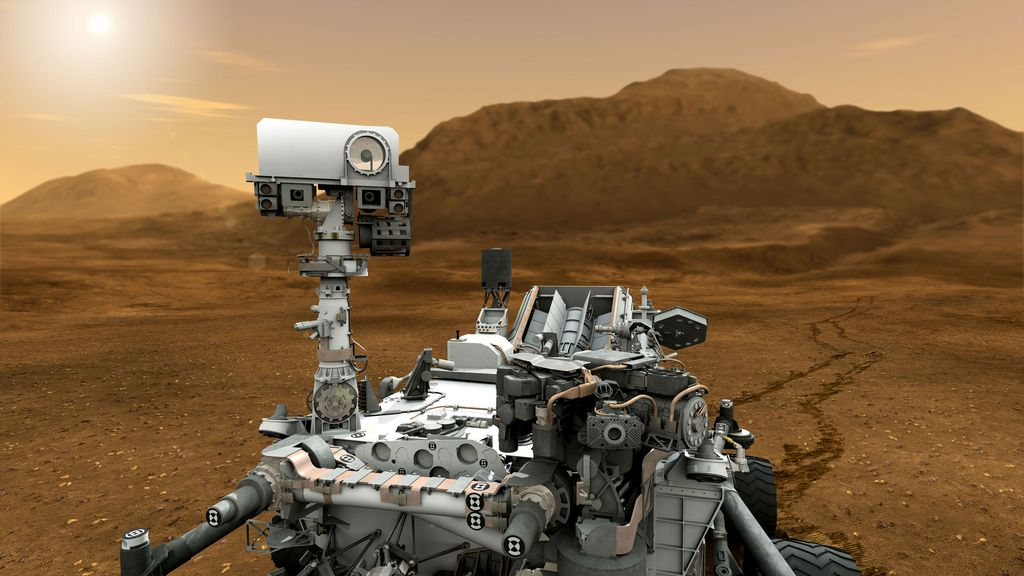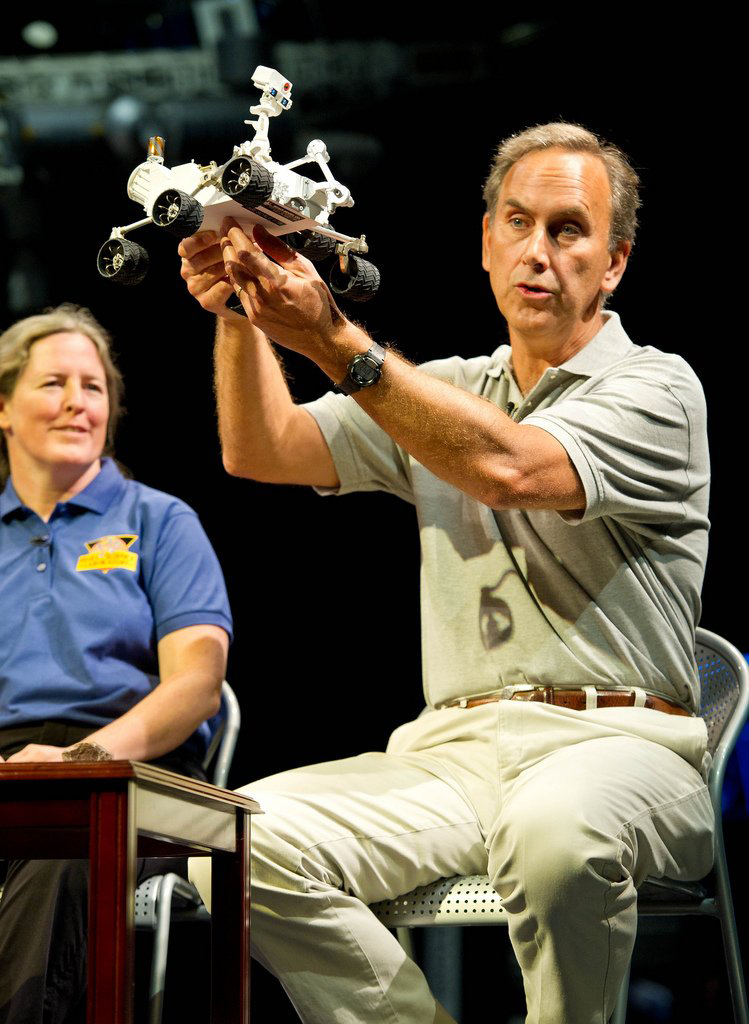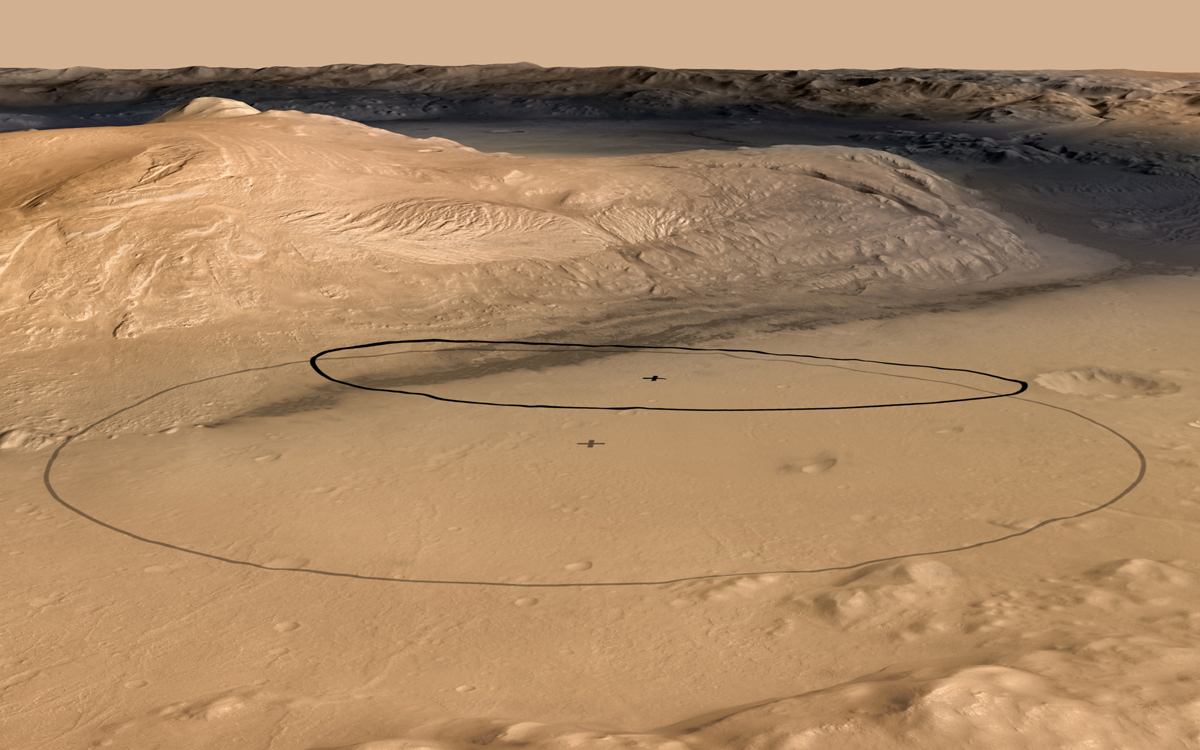
NASA's huge Curiosity rover is just days away from its highly anticipated, anxiety-inducing landing on Mars.
Curiosity, the centerpiece of NASA's $2.5 billion Mars Science Laboratory mission (MSL), is due to touch down inside the Red Planet's Gale Crater on Sunday night (Aug. 5). Curiosity will search the Gale area — including Mount Sharp, the 3-mile-high (5-kilometer) mountain rising from the crater's center — for clues that Mars is, or ever was, capable of supporting microbial life.
The 1-ton Curiosity is so big that engineers had to devise a new landing method for the rover. It will be lowered to the Martian surface on cables by a rocket-powered sky crane, which will then fly off and crash-land intentionally a short distance away.
SPACE.com caught up recently with MSL chief scientist John Grotzinger, a geologist at the California Institute of Technology in Pasadena. Grotzinger discussed how it feels to have landing right around the corner, what Curiosity might discover and how much is riding on this mission for NASA. [How Curiosity's Nail-Biting Landing Works (Pictures)]
SPACE.com: How does it feel to be so close to landing?

John Grotzinger: At this point, it's kind of what you would imagine. Everybody has been really going flat-out, and there are a lot of processes that we've sort of divided up and are responsible for and hoping to reach closure on — everything from things that relate to tactical planning and how we're going to do the final bits of staffing for the first six sols [Martian days], the first 20 sols, the first 30 sols.
I would say overall, everybody is ready. We've been preparing for this, most of us, anywhere between five and eight years of continuously and increasingly hard work. And at this point, we're just excited to get down on the ground and get going.
Get the Space.com Newsletter
Breaking space news, the latest updates on rocket launches, skywatching events and more!
At the same time, we're nervous. We're nervous about EDL [entry, descent and landing], we're nervous about the successful operations on the surface. But we're ready for it.
SPACE.com: You're landing in a very interesting place, so the stuff you do while checking out the instruments could be scientifically valuable, right?
Grotzinger: Right. It's kind of cool that we're landing where it looks like there's an alluvial fan that undergoes the transition to this high thermal inertia unit, whatever that is.
So we've got one unit that we think we know what it is, everybody tends to agree on that, but the high thermal inertia unit — nobody knows what that is, and we're going to land right on the contact between the two.
SPACE.com: How long after landing will it be before Curiosity starts heading off to Mount Sharp? A couple of months — is that the ballpark?
Grotzinger: Yeah, I would guess. [MSL project manager] Pete Theisinger likes to ballpark that we're going to probably be done with the instrument checkout and really be ready to drive and do opportunistic science without a lot of further restrictions probably on the order of 60 to 90 sols.
I support that. It's a conservative estimate, and purposefully so. And with luck, if everything goes well, we could start quite a bit sooner than that. But I think the team has discovered that on the way to Mount Sharp, we probably will not want to just hand the keys over to the rover drivers and say, "Just get us there."
Now, it might be that after we do some analyses, we find out that it's pretty uniform, in which case we would want to do something like that. But in the very beginning, we really want to try to characterize these units that are in the landing ellipse, just to make sure we don't miss something that's real exciting.
SPACE.com: So do you guys have a sense of what Mount Sharp is, and how it formed? There's really nothing like it on Earth, is there?
Grotzinger: No, not really. In one go, you have flat-lying strata that are 5 kilometers thick. There's nothing like that on Earth. So it makes it kind of hard; we don't really know what's going on there.

SPACE.com: What's the current best thinking about how this mountain took shape?
Grotzinger: I guess the consensus viewpoint is that the crater impact basin formed, and then after that water was available, at least on an episodic basis, and sediments accumulated. And they were either altered in the presence of the water or, alternatively, minerals in the water precipitated out. But one way or the other, they seem to have accumulated in the presence of water. [Photos: The Search for Water on Mars]
Initially, there were phyllosilicates that formed, mixed in with sulfates, and then later on it seems to be pretty much pure sulfates. And then after about 700 meters, we cross a contact and go into the rest of the mound, which seems to be built largely of strata again, but they A) do not show hydrated mineral signatures and B) in the upper reaches of Mount Sharp, they show very rhythmic bedding that's been discovered elsewhere on Mars and we think relates to climate cycles. As the climate goes through its cycle, wind pattern changes, and you deposit wind-blown materials in kind of a rhythmic pattern.
Something happened on Mars, and it went dry, and that's what we have today. The question is, what was that event? What was that trigger? What happened environmentally? My hope is that we'll get some insight into this Great Desiccation Event.
SPACE.com: What are some other Mars mysteries Curiosity could help solve?
Grotzinger: The materials that are in the landing ellipse — because of the alluvial fan and by inference we think the high thermal inertia unit — may have had something to do with water. That package of the alluvial fan plus the high thermal inertia — we have two options for that.
One option is that these are the very oldest materials at Gale Crater. So when we drive over to the base of Mount Sharp, if we get the right geological information, we may see that this unit extends under the mound, and it is the oldest unit and therefore this wet period of time in the history of Mars is consistent with everything we've known all along.
But what happens if those materials that we land on, with the alluvial fan and the high thermal inertia unit — what if they're the youngest thing at Gale Crater? That would be very exciting, because that would suggest that Mars maybe has a more complex environmental history than what we imagine.
We tend to look at everything that looks wet and say, It's very old. And we tend to look at things that are dry and say they're younger. But maybe there were periods of time that were young and also wet. That would be really cool. [7 Biggest Mysteries of Mars]
SPACE.com: In light of the recent funding cuts to NASA's planetary science and Mars programs, do you feel any extra pressure for Curiosity to succeed? NASA officials have said they're hoping this mission helps reinvigorate the Mars program by exciting interest among the public and politicians.
Grotzinger: I would say it's impossible not to worry on behalf of the Mars program. In terms of the tactical and strategic planning that we do, nothing will change that. Our objective is to go out and examine the goals that were stated for the mission at the outset and use our payload and rover as best as possible to try to achieve those goals. And I think that if we're successful in achieving those goals, the tide will rise for everybody.
So from that point of view, I don't worry about it. But what I do worry about is, if the pace of discovery is slow, if the Gale Crater and Mount Sharp field areas turn out to be a more difficult nut to crack than we think, people may feel that opportunities are being lost.
So that's why we all go out of our way at the beginning to ask for patience. We expect the story to be difficult to decipher. On the other hand, I have confidence that when we do figure it out, it's going to be a great story, and, like I say, I think the tide will rise for everybody. [NASA's 2013 Budget: What Will It Buy?]
SPACE.com: If something goes wrong with this mission, will the Mars program suffer?
Grotzinger: Yes, of course. I think if we are fatal on landing, that will have a very negative influence. It's going to force people to look back and ask if it's possible to achieve these very complex, more demanding missions from a technological perspective. How can you talk about sample-return if you can't do MSL first?
I'm certain that kind of conversation would come up. At the same time, I would always remind everybody that unless you try, you're just never going to know. That's the nature of this business. I think it is where NASA really defines itself, and you need to try these more difficult missions in order to find a way forward.

SPACE.com: Curiosity's power source could keep it roving for many years. Are you prepared to be chief scientist for the next decade, if it comes to that?
Grotzinger: That's a really good question (laughs). Our prime mission is two years, and I think one has to constantly keep in mind where the Mars program is. For me personally, I'm thrilled to have the opportunity to help lead the science team for the prime mission. After that point, we'll see where we are.
If everything's going really well and we've made a lot of discoveries and things are great, it may be appropriate for somebody else to come in and steer the ship. And partly the reason for that is, we may not have any other missions for people to look forward to, and I think maybe it's time to evolve the model by which we do these missions that go on for a decade in order to create opportunities for other people to have some fun.
If, on the other hand, we're going along and it's been a tough slog and yet there's real grounds for optimism but we haven't really achieved the success that we were hoping for, I think I feel the commitment to stick with it and follow through on the strategic planning and the basis for the mission, and make sure that we've really delivered what we think we can deliver.
Follow SPACE.com senior writer Mike Wall on Twitter @michaeldwall or SPACE.com @Spacedotcom. We're also on Facebook and Google+.
Join our Space Forums to keep talking space on the latest missions, night sky and more! And if you have a news tip, correction or comment, let us know at: community@space.com.

Michael Wall is a Senior Space Writer with Space.com and joined the team in 2010. He primarily covers exoplanets, spaceflight and military space, but has been known to dabble in the space art beat. His book about the search for alien life, "Out There," was published on Nov. 13, 2018. Before becoming a science writer, Michael worked as a herpetologist and wildlife biologist. He has a Ph.D. in evolutionary biology from the University of Sydney, Australia, a bachelor's degree from the University of Arizona, and a graduate certificate in science writing from the University of California, Santa Cruz. To find out what his latest project is, you can follow Michael on Twitter.









